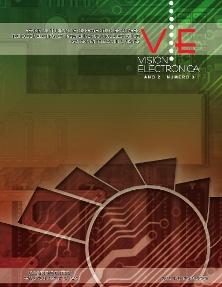DOI:
https://doi.org/10.14483/22484728.18415Publicado:
2019-03-13Número:
Vol. 2 Núm. 1 (2019): Edición especialSección:
Visión de CasoThermosyphon effect in parabolic trough collector systems
Efecto termosifón en sistemas con colectores cilíndrico parabólicos
Palabras clave:
Colector cilíndricoparabólico, Termosifón, Fluido de transferencia de calor, Convección natural, Energía solar, Simulación de flujo (es).Palabras clave:
Parabolic trough collector, Thermosyfon, Heat transfer fluid, Natural convection, Solar energy, Flow simulation (en).Descargas
Resumen (en)
Thermosyphon effect is a natural convection phenomenon that gives a fluid the possibility to circulate inside a closed loop without any external pump sources. Numerical and simulation analysis are driven to check the behavior of thermosyphon effect in different heat transfer fluids, using parabolic trough collectors as the heating section of the system. Also, convection and radiation losses are considered. Simulations show variations in fluids density caused by different temperature and specific heat values, altering the velocity of the fluid inside the system with the same initial conditions.
Resumen (es)
El efecto termosifón es un fenómeno de convección natural que le da a un fluido la posibilidad de circular dentro de un circuito cerrado sin ninguna fuente de bomba externa. En el presente artículo de investigación se realiza el análisis numérico y de simulación para verificar el comportamiento del efecto termosifón en diferentes fluidos de transferencia de calor, utilizando colectores cilindroparabólicos como sección de calentamiento del sistema. Además, se consideran las pérdidas por convección y radiación. Se obtiene que las simulaciones muestran variaciones en la densidad de los fluidos causadas por diferentes temperaturas y valores de calor específicos, alterando la velocidad del fluido dentro del sistema bajo las mismas condiciones iniciales.
Referencias
A. Hurlimann, G. Warren-Myers, “Is the Australian construction industry prepared for climate change?”, Geoffrey Browne, Building and Environment, 2019. https://doi.org/10.1016/j.buildenv.2019.02.008
O. Ellabban, H. Abu-Rub, and F. Blaabjerg, “Renewable energy resources: Current status, future prospects and their enabling technology,” Renew. Sustain. Energy Rev., vol. 39, pp. 748–764, 2014. https://doi.org/10.1016/j.rser.2014.07.113
A. Dombrovsky, A. Kokhanovsky, H. Jaona, “Randrianalisoa, On snowpack heating by solar radiation: A computational model”, Journal of Quantitative Spectroscopy and Radiative Transfer, vol. 227, pp. 72-85, 2019. https://doi.org/10.1016/j.jqsrt.2019.02.004
H. L. Zhang, J. Baeyens, J. Degrève, and G. Cacères, “Concentrated solar power plants: Review and design methodology,” Renew. Sustain. Energy Rev., vol. 22, pp. 466–481, 2013. https://doi.org/10.1016/j.rser.2013.01.032
M. Orosz, P. Mathaha, A. Tsiu, B. M. Taele, L. Mabea, M. Ntee, M. Khakanyo, T. Teker, J. Stephens, and A. Mueller, “Low-cost small scale parabolic trough collector design for manufacturing and deployment in Africa,” in AIP Conference Proceedings, vol. 1734, 2016. https://doi.org/10.1063/1.4949040
L. Guzman, A. Henao, and R. Vasqueza, “Simulation and optimization of a parabolic trough solar power plant in the city of Barranquilla by using system advisor model (SAM),” in Energy Procedia, vol. 57, pp. 497–506, 2014. https://doi.org/10.1016/j.egypro.2014.10.203
A. Fernández-García, E. Rojas, M. Pérez, R. Silva, Q. Hernández-Escobedo, and F. Manzano-Agugliaro, “A parabolic-trough collector for cleaner industrial process heat,” J. Clean. Prod., vol. 89, pp. 272–285, 2015. https://doi.org/10.1016/j.jclepro.2014.11.018
H. Jafari Mosleh, S. J. Mamouri, M. B. Shafii, and A. Hakim Sima, “A new desalination system using a combination of heat pipe, evacuated tube and parabolic through collector,” Energy Convers. Manag., vol. 99, pp. 141–150, 2015. https://doi.org/10.1016/j.enconman.2015.04.028
V. K. Jebasingh and G. M. J. Herbert, “A review of solar parabolic trough collector,” Renewable and Sustainable Energy Reviews, vol. 54. pp. 1085–1091, 2016.https://doi.org/10.1016/j.rser.2015.10.043
V. Drosou, L. Valenzuela, and A. Dimoudi, “A new TRNSYS component for parabolic trough collector simulation,” Int. J. ustain. Energy, pp. 1–21, Nov. 2016. https://doi.org/10.1080/14786451.2016.1251432
P. Mohammad Zadeh, T. Sokhansefat, A. B. Kasaeian, F. Kowsary, and A. Akbarzadeh, “Hybrid optimization algorithm for thermal analysis in a solar parabolic trough collector based on nanofluid,” Energy, vol. 82, pp. 857–864, 2015. https://doi.org/10.1016/j.energy.2015.01.096
G. Lopez, J. Mantilla, and B. Poveda, “Evaluación de un calentador solar de agua fabricado con tubería PVC en serie y envases PET translucidos,” Rev. Tecnura, vol. 16, pp. 120–128, 2012. https://doi.org/10.1016/j.seta.2018.08.006
J. G. Rueda-Bayona, A. Guzmán, J. J. Cabello Eras, R. Silva Casarín, E. Bastidas Arteaga, J. Horrillo Caraballo, “Renewables energies in Colombia and the opportunity for the offshore wind technology”, Journal of Cleaner Production, vol. 220, pp. 529-543, 2019. https://doi.org/10.1016/j.jclepro.2019.02.174
A. M. Aguirre-Mendoza, C. Díaz-Mendoza, J. Pasqualino, “Renewable energy potential analysis in non-interconnected islands”. Case study: Isla Grande, Corales del Rosario Archipelago, Colombia, Ecological Engineering, 2017. https://doi.org/10.1016/j.ecoleng.2017.08.020
E. F. Henao, Y. Rodriguez, J. P. Viteri, I. Dyner, “Optimising the insertion of renewables in the Colombian power sector”, Renewable Energy, Vol. 132, pp. 81-92, 2019. https://doi.org/10.1016/j.renene.2018.07.099
P. Soto, L.A. Domínguez-Inzunza, W. Rivera, “Preliminary assessment of a solar absorption air conditioning pilot plant”, Case Studies in Thermal Engineering, vol. 12, pp. 672-676, 2018. https://doi.org/10.1016/j.csite.2018.09.001
A. Alizadehdakhel, M. Rahimi, and A. A. Alsairafi, “CFD modeling of flow and heat transfer in a thermosyphon,” Int. Commun. Heat Mass Transf., vol. 37, no. 3, pp. 312–318, 2010. https://doi.org/10.1016/j.icheatmasstransfer.2009.09.002
Cómo citar
APA
ACM
ACS
ABNT
Chicago
Harvard
IEEE
MLA
Turabian
Vancouver
Descargar cita
Licencia
Derechos de autor 2019 Visión electrónica

Esta obra está bajo una licencia internacional Creative Commons Atribución-NoComercial 4.0.
.png)
atribución- no comercial 4.0 International






.jpg)





